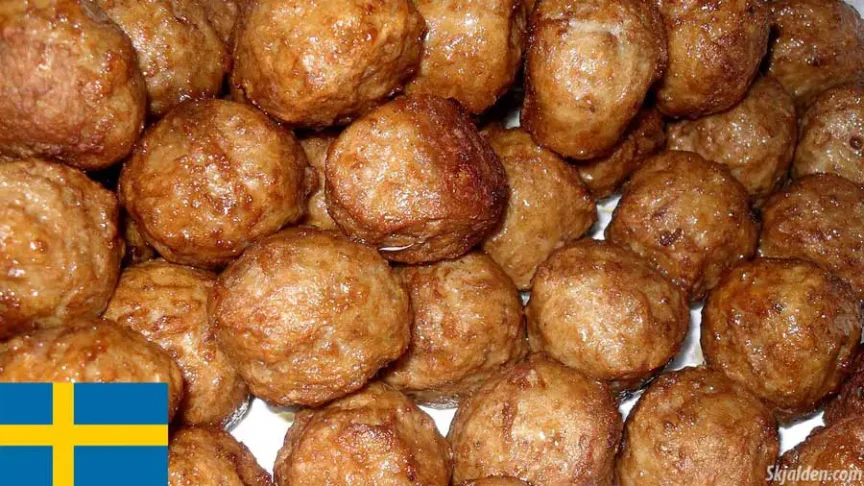Swedish meatballs, or Köttbullar, are a staple of Swedish cuisine, known and loved far beyond the borders of Sweden. This simple yet delicious dish is more than just food; it’s a piece of Swedish heritage that has made its way into kitchens and restaurants worldwide.
Swedish meatballs are small, round, and traditionally made from a mix of ground beef and pork. The blend of meats gives the balls a tender, juicy texture and a rich flavor. They’re seasoned with spices like salt, black pepper, and often allspice or nutmeg, which adds a distinctive taste. Bread crumbs and milk are mixed into the meat to make the balls light and airy. They are typically fried in butter, giving them a lovely golden-brown crust.
Global History and Cultural Roots of Meatballs
The tradition of making meatballs is widespread, with variations found in many cultures around the world, including throughout Sweden and Scandinavia long before the term “köttbullar” was first recorded. In ancient Rome, a dish similar to meatballs, known as “Isicia Omentata,” was prepared with minced meat, bread, and wine, showcasing an early example of meatball preparation in historical cuisine.
Historically, the concept of forming meat into round shapes can be traced back to ancient times, evidenced in Roman cookbooks and other historical sources. These early versions of meatballs, or their culinary ancestors, have been part of human diets across different cultures, indicating a universal method of preparing meat.
In Sweden, meatballs were most likely a known concept well before the 18th century, but it was during this time that they became more prominent in cookbooks and household cooking, coinciding with the increased availability of kitchen tools like the meat grinder.

Do Meatballs come from Turkey?
The narrativev highlighted by the Hürriyet Daily News and Sweden’s official national Twitter account, @swedense, suggesting that Swedish meatballs were based on a recipe brought from Turkey by King Charles XII, sparked considerable debate.
It is essential to clarify, however, that while Charles XII might have encountered and brought back various culinary practices from his time in the Ottoman Empire, attributing the origins of Swedish meatballs directly to Turkish cuisine might oversimplify the complex interplay of cultural influences.
The Ottoman Empire was a vast and diverse realm that included many peoples and cultures, including Greeks, Armenians, and other Balkan communities, which were part of the empire due to conquest and were not ethnically Turkish.
Cultural Influences and Culinary Exchange
The assertion made on the Swedish Twitter account led to discussions and reflections within and beyond Sweden. Annie Mattsson from Uppsala University pointed out that Charles XII sought refuge in the region now known as Moldova, then under Ottoman control, after his defeat by Russia. Upon his return to Sweden, he reportedly introduced various elements from the local cuisine he encountered, which might have included dishes from the broader Ottoman culinary spectrum, not exclusively “Turkish” in the modern ethnic sense.
The introduction of coffee, which became a widespread tradition in Sweden, is a well-documented influence from Charles XII’s sojourn. However, the association of Swedish meatballs with Charles XII’s experiences in the Ottoman lands should be viewed with consideration of the empire’s multicultural composition. The dishes he brought back, such as köfte or the inspiration behind kåldolmar, were part of a culinary tradition that spanned several cultures within the Ottoman Empire.
The international discussion, including the reaction from Turkey’s meatball capital, Inegöl, and comments from Turkish officials, reflects the pride and cultural significance attached to these culinary traditions. Yet, the assertion by some that Swedish meatballs should not be considered a Swedish dish due to their supposed foreign origins ignites a broader conversation about cultural exchange, appropriation, and the evolution of national cuisines.
In this context, comparing the situation to other regions where culinary practices were influenced by conquest and cultural assimilation, such as the Roman influence on British cuisine or the Arab impact on Spanish cooking, helps illustrate the complexity of tracing a dish’s origins.
Therefore, while acknowledging King Charles XII’s role in introducing certain customs and possibly inspiring new dishes in Sweden, it is crucial to recognize the multifaceted roots of these culinary traditions, which may draw from the diverse cultures that were part of the Ottoman Empire, such as Greeks, Armenians, and other Balkan communities rather than attributing them solely to Turkish influence.
Swedish Meatballs Around the World
Swedish meatballs have gained international fame, significantly helped by IKEA’s global reach. At IKEA, visitors worldwide can sample Swedish meatballs served with creamy gravy, lingonberry jam, and potatoes. This has helped transform köttbullar from a national favorite into a global culinary sensation.
But the love for Swedish meatballs goes beyond IKEA. These meatballs are a reminder of home for Swedes living abroad and have become a popular dish among food enthusiasts everywhere. They are celebrated for their comfort and simplicity, embraced in various settings from casual meals to festive occasions.
Final words
While Swedish meatballs, or Köttbullar, have sparked international curiosity and debate regarding their origins, it is clear that they are a cherished component of Sweden’s rich culinary heritage. Despite historical interactions and the exchange of culinary practices, such as those possibly influenced by King Charles XII’s time in the Ottoman Empire, Swedish meatballs remain fundamentally tied to Swedish traditions and history.
The journey from local kitchens to global fame highlights not just the adaptability and universal appeal of this beloved dish but also the enduring connection to its Swedish roots. Swedish meatballs have transcended borders, becoming a symbol of comfort and culinary craftsmanship worldwide, while continuing to celebrate their unmistakably Swedish origin.
